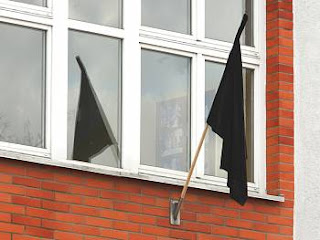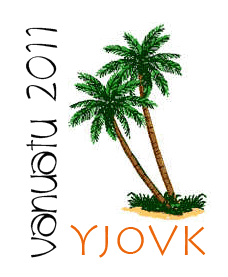60 meters beacons
DARC beacon project

The Deutscher Amateur Radio Club (DARC) sponsors two beacons which transmit from Scheggerott, near Kiel (54.68750N - 9.791670E, JO44VQ). [8] These beacons are DRA5 on 5195 kHz and DK0WCY on 10144 kHz. In addition to identification and location, every 10 minutes these beacons transmit solar, geomagnetic and ionospheric bulletins. Transmissions are in Morse code (CW) for aural reception, RTTY (45 baud 170 Hz at HH+10) and PSK31 (at HH+50). [9] DK0WCY operates also a limited service beacon on 3579 kHz at 0720-0900 and 1600-1900 local time.

RSGB 5 MHz beacon project
The Radio Society of Great Britain (RSGB) operates three radio propagation beacons on 5290 kHz, which transmit in sequence, for one minute each, every 15 minutes. The project includes GB3RAL near Didcot (51.56250N - 1.291670W, IO91IN), GB3WES in Cumbria (54.56250N - 2.6250W, IO84QN) and GB3ORK in the Orkney Islands (59.02080N - 3.208330W, IO89JA).
Beacon GB3RAL, which is located at the Rutherford-Appleton Laboratory, also transmits continuously on 28215 kHz and on a number of low VHF frequencies (40050, 50053, 60053 and 70053 kHz).[10]
As part of an International Telecommunications Union-funded project, radio propagation beacons were installed by national authorities at Sveio, Norway (callsign LN2A, 59.60420N - 5.291670E) and at Darwin, Australia (callsign VL8IPS, 12.60420S - 131.29200E). The beacons operated on frequencies 5471.5 kHz, 7871.5 kHz, 10408.5 kHz, 14396.5 kHz, and 20948.5 kHz.[6] Since 2002, there have been no reception reports for these beacons and the relevant ITU web pages have been removed. [7]
HF Field-Strength measurement campaign For a number of years, ITU-R Study Group 3 has been promoting a world-wide HF field-strength measurement campaign, the impetus for which arose from WARC HFBC-87 and the request for improved accuracy in HF propagation prediction. At that time, the Study Group recognised that significant improvements in HF propagation prediction methods needed a substantial body of new measurement data and to that end, administrations and organisations were invited to participate in the measurement campaign, either by installing suitable transmitters or by collecting long-term data from appropriate receiving systems. The campaign is specified in Recommendation ITU-R P.845 'HF field-strength measurement' and comprises a world-wide network of transmitters and receivers using coded transmissions on pre-determined frequencies.
The reasons for the campaign and the continuing need for participation in it, are underlined in Resolution ITU-R 27 (HF field-strength measurement campaign). So far, regular transmissions are being provided by the Administrations of Australia and Norway. Details of the transmitter in Norway, operated by the Norwegian Telecommunications Authority and Telenor Broadcasting, are given below:
Radio Beacon LN2A
- Identification signal (Morse code): LN2A
- Location: Sveio, Norway 59 deg 37 min N, 5 deg 19 min E
- Hours of transmission: 24 hours per day
- Assigned frequencies: 5471.225 kHz, 7871.225 kHz, 10408.225 kHz, 14396.225 kHz and 20946.225 kHz
- Reference frequencies, corresponding to suppressed carrier frequencies when using suppressed carrier SSB techniques: 5470 kHz, 7870 kHz, 10407 kHz, 14395 kHz and 20945 kHz
- Transmitter: ICOM IC 725 transceiver, IC-4KL PA
- Transmitted power: approximately 1 kW on all frequencies
- Antenna: 5 band trap vertical monopole
- Mode: Suppressed carrier SSB, with the reference frequencies (suppressed carrier frequencies) 1225 Hz below the assigned frequencies, with the FSK "mark" 800 Hz above the reference frequency, and the FSK "space" 1650 Hz above the reference frequency.
- Signal duration and format: as specified in Recommendation ITU-R P.845; 4 min for each frequency, 20 min for all five frequencies according to the following schedule:
| Reference frequency (kHz) | Minutes after each hour |
| 14395 | 00 - 20 - 40 |
| 20945 | 04 - 24 - 44 |
| 5470 | 08 - 28 - 48 |
| 7870 | 12 - 32 - 52 |
| 10407 | 16 - 36 - 56 |
Administrations and organizations participating in the work of ITU-R are invited to consider the possibility of participating in the campaign, either through the provision of transmissions or by the collection of field strength measurement data, both in accordance with the specifications given in Recommendation ITU-R P.845. For further details on the campaign, including the availability of a suitable receiving system, please contact the ITU-R Counsellor for Study Group 3 (Dr. Kevin A. Hughes) at ITU Headquarters, in Geneva.
The Norwegian Telecommunications Authority and Telenor Broadcasting would be pleased to acknowledge reception reports of LN2A with a QSL card.
The contact address is:
Norwegian Telecommunications Authority (Att. AYO/TF)
P O Box 447 Sentrum
N-0104 Oslo
Norway
In addition to the DARC and RSBG beacon projects on 5195 and 5290 kHz (see below), Eddie Bellerby of UDXF discovered in March 2011 a new CW beacon on 5206 kHz, sending LX0HF, presumably from Luxembourg.[13] Further intelligence indicates that the beacon is operated by Philippe LX2A/LX7I of the Luxembourg Amateur Radio Society.[14] Two more european beacons are listed on 5 MHz, OV1BCN on 5290 kHz, operated by OZ1FJB and more or less experimental operation then real beacon by OK1IF on 5258.5 kHz from the Czech Republic on random basis.
----
Notes and references
- Andy Talbot, G4JNT: "Amateur Beacons", Radio User, ISSN 1748-8117, 3(5), pp.56-58 (May 2008). The article includes the following definition for beacons licensed in the Amateur Radio service: A station in the Amateur Service or Amateur Satellite Service that autonomously transmits in a fixed format, which may include repeated data or information, for the study of propagation, determination of frequency or bearing, or for other experimental purposes.
- Andy Talbot, G4JNT: "Amateur Beacons", Radio User, ISSN 1748-8117, 3(8), pp. 30-33 (August =2008)
- New IARU Region 2 bandplan introduced in January 2008
- Amateur Radio UK VHF Bandplan, Great Yarmouth Radio Club
- International Beacon Project by the Northern California DX Foundation (2008)
- HF 0-20 MHz beacons
- ITU Resolution ITU-R 27/1993: HF Field-strength measurement campaign (PDF)
- Aurora beacon DKØWCY by Deutscher Amateur-Radio-Club e.V.(DARC), 2004.
- Pat Hawker, G3VA: "The DK0WCY/DRA5 Propagation Beacons", Technical Topics Scrapbook - All 50 years, Radio Society of Great Britain, ISBN 9781-9050-8639-9, pp. 98 (2008)
- Mike Willis, G0MJW: "The GB3RAL VHF Beacon cluster", RadCom, 84(04), Radio Society of Great Britain, pp. 65-59, April 2008
- The Four meters website: 70 MHz beacon list
- The Four meters website: RSGB 4m bandplan
- Southgate Amateur Radio Club: Luxembourg 60m beacon LX0HF
- Luxembourg: Une balise sur 60m LX0HF Radioamateurs-Online, March 11, 2011.
| Callsign | Frequency | Locator | Details |
| DRA5 | 5195.0 kHz | JO44VQ | DARC |
| LX0HF | 5205.3 kHz |
|
|
| OK1IF | 5258.5 kHz | JO40HG | Recording: [1] |
| GB3RAL | 5290.0 kHz | IO91IN | RSGB |
| GB3WES | 5290.0 kHz | IO84QN | RSGB |
| GB3ORK | 5290.0 kHz | IO89JA | RSGB |
| OV1BCN | 5290.0 kHz | JO55SI | Op OZ1FJB [2]
|
 Hi all. I would like to thanks to all of You for QSO, trials, support, effort, help, tips, hints... simply for great camaraderie which I felt on 60m band each second when I was on the air.
Hi all. I would like to thanks to all of You for QSO, trials, support, effort, help, tips, hints... simply for great camaraderie which I felt on 60m band each second when I was on the air.








